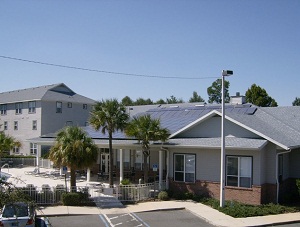Gainesville has high PV penetration thanks to FiT
 With all the brouhaha about giant solar plants going up in the U.S. Southwest, you’d think the highest amount of solar per capita would be in one of those states—and California does have the highest amount of solar on a state level. But California is bested by Gainesville, Fla., which may have the highest penetration of solar in the U.S, thanks to its feed-in tariff.
With all the brouhaha about giant solar plants going up in the U.S. Southwest, you’d think the highest amount of solar per capita would be in one of those states—and California does have the highest amount of solar on a state level. But California is bested by Gainesville, Fla., which may have the highest penetration of solar in the U.S, thanks to its feed-in tariff.
The city of roughly 200,000 people has 36 watts of solar installed per person. That’s higher than the 32 watts of solar installed per person in California, according to renewable energy expert Paul Gipe.
The likely culprit for the amount of solar? Gainesville Regional Utility’s feed-in tariff (FiT), which offered up to 32 cents per kilowatt hour (kWh) for installed systems up to 10 kW or less. For systems up to 1 megawatt, it offered 24 cents per kWh.
The utility offers a FiT as well as net-metering to customers. It chose to offer the FiT because it doesn’t require an upfront rebate from the municipally owned utility, according to John Crider, a generation planning engineer.
“The primary driver in the choice between the two was to place the burden of performance on the owner of the system,” he said.
The utility also offers rebates for solar and net-metering. But without the performance incentive of the higher FiT rate, the utility found that some solar installations weren’t performing at their maximum capacity, meaning that neither the utility nor the customer was getting the most out its investment.
“We already had these funds committed, and it was a different way to commit them,” he said. “It’s also the best way to make sure the owners had their systems working at their peak.”
Under other rebate structures, the utility also had to send staff out to help small solar producers maximize the amount they were getting from their systems.
“[Under the tariff] we had a similar dollar investment in our program but didn’t have to apply staff resources,” Crider said.
The FiT also is helping the utility get more solar for less. Crider compared the cost of adding in solar for Gainesville to the new, 32-MW Long Island Solar Farm.
“Under a feed-in tariff, we could have gotten 50 percent more solar at the same cost,” he said.
He estimated that the Long Island plant cost about 30 cents per kWh.
“Usually we have the sense that bigger is better, but we find that we can get a lot more megawatt hours producing in a shorter amount of time [under the feed-in tariff],” he said.
The program is covering 4 megawatts of new solar annually, and it’s fully subscribed through 2013. At that point the utility will likely reopen the program to more customers.
Image courtesy of Gainesville Regional Utilities.



